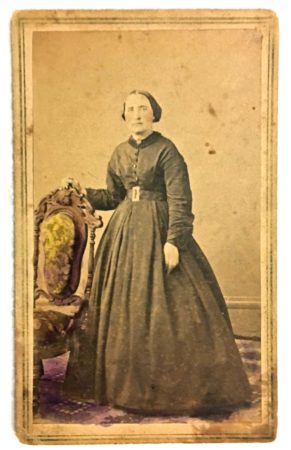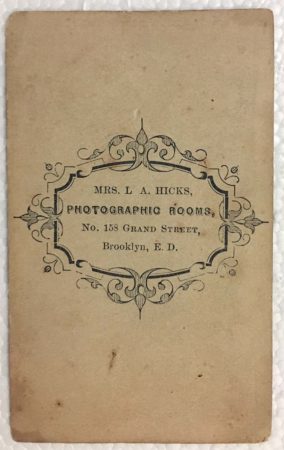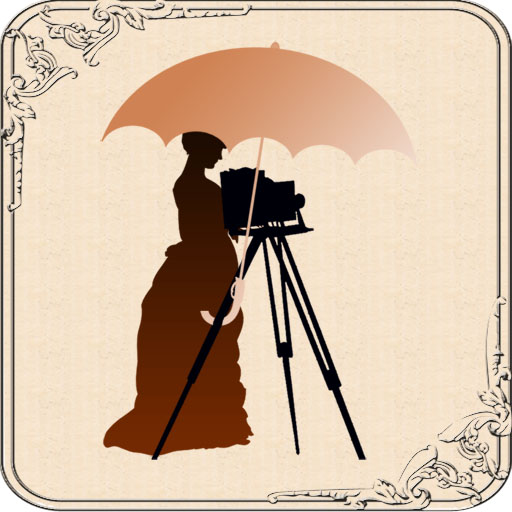Notes
Here’s that hand-tinted Carte de Visite photo by Mrs L.A. Hicks that I talk about in today’s episode:


Mrs. Hicks was a contemporary of two other women we’ve already met here on the podcast, women who opened their own photographic studios in the mid 1800s. Click on their names below to listen to the episodes that discuss their stories.
Lifeline
Recommended Links
- Ancestry.com (census records, city directories, and more; paid account required – Visit
- Family Search website has U.S. Federal Census and more; free account required – Visit
- Geneologybank.com has a selection of digitized newspapers from the United States; paid account required – Visit
- Newspapers.com has a selection of digitized newspapers from the United States; paid account required – Visit
- Newspaperarchives.com has a selection of digitized newspapers from the United States; paid account required – Visit
Transcript
You’re listening to Photographs, Pistols, and Parasols.
Support for this project is provided by listeners like you. Visit my website at p3photographers “dot” net for ideas on how you, too, can become a supporter of the project.
Welcome to Photographs, Pistols & Parasols, the podcast where we celebrate early women artisan photographers.
I’m your host, Lee McIntyre.
Today we’re going to learn some tantalizing bits and pieces from the life of Mrs Lydia A. Hicks, a very early artisan photographer in Brooklyn, New York.
For more information about any of the women discussed in today’s episode, visit my website at p3photographers.net.
That’s letter “p”, number “3”, photographers “dot” net.
*****
Before I start today’s episode, first I should explain what has happened to {art 3 of the “women from Lawrence.”
Well, as they say, best laid plans have a way of going astray.
And that’s definitely the case with my original plans for Season 3 here on Photographs, Pistols & Parasols.
I mean, first, I had to take a hiatus because I was moving and starting a new job.
But reason for postponing the rest of the women from Lawrence, though, is actually due to an unexpected turn of events … because I’ve been invited to give a talk in Lawrence in the Spring, at the University of Kansas.
So, rather than go into all of the women from Lawrence right now, I’m going to postpone talking about the rest of them.
I will share more details about the talk, as well as more about the final women from Lawrence, as soon as everything starts to gel for that talk.
Another reason my Season 3 plans have changed somewhat is that I also got a paper accepted at the American Historian Association’s Annual Conference, which is happening at the beginning of January.
I’m really excited to bring the women that I’ve been researching to this new audience, and I’m already hard at work putting that presentation and materials together.
Now have no fear — new episodes of the podcast are going to continue, hopefully on the regular schedule twice a month.
But in the meantime, I’m going to be putting that Lawrence stuff on hold and just bring you some interesting stories that I’ve been researching and running across over the past few months.
For example, my husband and I picked up a very interesting picture by a woman that we hadn’t heard of, and it’s led to some little bits and pieces of information that I wanted to share.
As I said, it started with a fascinating photo by a woman named Mrs L. A. Hicks from Brooklyn.
Now, she was a very early photographer.
Her full name was Lydia A. Hicks.
She was born in 1830; as for her death … well, we’ll get to that in a minute.
By the late 1850s, she and her husband were running a daguerrean gallery in Brooklyn, New York.
On the back of the photo that I have, Mrs. Hicks gives her address as 158 Grand in Brooklyn, E. D.
Now I don’t know about you, but I didn’t really know much about the history Brooklyn.
It turned out that in 1855, 2 towns were annexed by the city of Brooklyn, forming what was called the “Eastern District” = E. D.
So, that’s where Mrs. Hicks’ studio is.
The photo is not into daguerreotype; it is a carte de visite, which is one of those cardboard photos with the photo pasted on top.
Mrs Hicks was a daguerrean, but she probably changed — like most photographers did — to follow the fashion of the CDV, the cheaper, probably easier to produce cards that enjoyed a real popularity starting in the late 1850s, going all the way until the 1870s.
In any case, this particular CDV is a portrait of a woman.
And the woman’s style of dress is like that you’d associate with the Civil War [period], with a big puffy skirt.
She’s not wearing a hoop but it is big voluminous dress.
Now the woman in the image is standing — so you can really admire her dress.
And she’s standing next to a chair, and her hand is resting on the back of the chair.
The chair is upholstered, and women’s also standing on a carpet.
I mention those things because this CDV is a really good example of what’s called hand-tinting.
I don’t bring it up very often, but even though we think of stuff being in black and white back in the 1800s, in fact although the images were black and white, but it was really quite the trend to add some color, i.e. just paint in a little bit of color to colorize or tint the image.
And this photo by Mrs Hicks is a really good example of that.
There’s little pink dotted on the cheeks of the woman in the photo.
There’s green on the chair’s upholstery, and there is also a little bit of pink or purple in the carpet.
Of course it’s hard to understand exactly what the colors would have been, because [the color] has probably degraded a little bit over time.
But even so, you can still get a clear understanding of the type of tinting that was done on this photo.
I know Mrs Hicks is running at studio from, as I said the late 1850s all the way until at least 1870.
But there’s not a lot of information about her in the newspapers.
That’s probably because she was in a bigger city.
I mean, what we [my husband and I] have found in our research is that it’s really hard to find a lot of information for women who lived in the bigger cities and towns, because [in the bigger cities] there aren’t the kinds of social notices and comings and goings and parties and things that you see in the small town newspapers.
Mrs. Hicks was there in Brooklyn, and the Brooklyn Eagle [newspaper] did cover one event in 1863 which they found as a real cause celeb, because it was such a sort of hint of scandal in some ways, because it was a dispute between a husband and wife.
Originally Mrs Hicks, whose name first name was Lydia, and her husband, Lemuel, ran that gallery together.
But according to this article in 1863 — which is actually about events which I’ll describe in a moment — in passing the article mentions that the Hickses had actually separated prior to July 1863 due to a scandal … or at least scandalous rumors … of a lady daguerrean having some sort of association with a prominent Washington, DC official.
I gather that maybe [the rumors] were never proved, but the article says that in the subsequent separate and divorce, Mrs Hicks actually was awarded the original gallery (the one at 158 Grand) and Mr Hicks then opened up a competing studio down the street.
Now the articles in 1863 give that as a back story for what’s just happened in July 1863.
[It seems that] Mrs Hicks was giving a party where men and women were in attendance.
And Mr Hicks was not happy about this.
So he storms down the street and breaks into the party, and the party disperses.
Mr Hicks proceeds to break all the furniture in the room.
As a result, Lydia Hicks brings charges of malicious mischief for damages done to all the furniture in her gallery.
So Mr Hicks — Lemuel — has to stand trial.
From Mrs Hicks’ point of view she was divorced from Mr Hicks, and [she] was now the sole owner of the gallery and all its content.
So he had no right to come in and break everything up.
But as it turns out, from Mr Hicks’ point of view, they were not divorced.
He didn’t think it [the divorce] was legal because apparently it had been filed in Indiana, and he didn’t think his wife had ever lived in Indiana.
So he’s claimed he had been forced to sign a document that signed over everything to his wife, and from his point of view, she was his wife. I.e., they were not divorced so she was not his “ex-wife.”
Anyway, he breaks up the party and gets arrested.
And, you know, the coverage [in the newspaper] is really not very sympathetic to him.
I mean, they describe Mrs Hicks as “a small, light-made woman with a brunette complexion and small hazel eyes to match.”
The articles go on to describe how successful she is as a business woman.
And they sort of derisively comment that while [Mrs. Hicks] opened that daguerrean gallery, Mr. Hicks came into the business later; he started as a shoe salesman on the bottom floor [before he became a photographer].
But anyway, at this point, Mr Hicks is running a gallery down the street, he’s no longer a shoe salesman.
He doesn’t really help his cause in this complaint because he actually fails to show up in court.
A warrant is issued for his arrest when he doesn’t show up, his bail is revoked … and after 26 hours, the paper reports that he still has not been tracked down – he’s still on a walk about.
That’s the end of July 1863.
However, it is the Brooklyn Eagle newspaper coverage that I depend on for what I just explained to you.
But it actually stops there.
It never says what happened.
Did he pay a fine?
Did he eventually get tracked down and arrested?
Was he put in jail?
We’ll never know.
Now, I can tell you that Lemuel doesn’t stay in jail forever, because he eventually gets remarried.
And throughout the 1870s and into the 1880s he actually continues to run his photography gallery there in Brooklyn.
Actually both of the Hickses continue operate their gallerys at least through the 1860s there in Brooklyn.
Amusing, 1866, the Brooklyn city directory has a listing for “Lemuel S. Hicks, photographer”, and then right below that is a listing for “Lydia A. Hicks, photographer” – and she’s also listed as a being a widow.
Obviously there was no love lost between them.
In 1870 there’s a notice in the newspaper that Lydia wants to sell her business at a 158 Grand.
She says that she plans to retire, but she still listed in the Brooklyn directory in 1871, though as an artist, still at that 158 Grand address.
Her [ex]husband has also rebranded himself as an artist that year, so again you have this odd positioning of the two of them sort of side by side in the listing, where Lydia is once again listed as a “widow.”
But after that, well, Lydia Hicks’ trail goes cold.
Lydia and Lemuel have a son named Augustus, and Augustus actually becomes a photographer eventually as well.
In fact, he and his father turn up throughout the 1870s and into the 1880s there in Brooklyn running photography studios, both separately and together.
As for Lydia, well, it’s hard to know what exactly happened her.
I mean, my husband, Chris, and I found a reference for a Lydia A. Hicks who dies in 1911, but there’s no way to connect that Lydia to the Lydia Hicks who was a photographer in Brooklyn.
And, consider that in 1870, when she says she wants to retire, well she would only been 40 years old.
So, she could well have gotten remarried.
But so far no trace of any marriage records or anything like that have emerged from any online searches.
The one thing that we have, at least, is evidence of this woman’s artistry – I mean her photographic skills – and also her business accumen for running a studio for over 10 years [at least].
And that’s all represented by that beautiful hand-tinted CDV that’s produced by Mrs L. A. Hicks from Brooklyn, E.D.
*****
You’ll be able to see that CDV by Mrs Hicks, with its beautiful hand-tinted coloring, on my website at p3photographers.net. That’s letter “p” number “3” photographers “.” net
If you have any questions or want to drop me a line, send an email to podcast “at” p3photographers.net.
Also, remember you can follow Photographs, Pistols & Parasols on Facebook at facebook.com/p3photographers.
As I look forward to coming year, it looks like it’s going to be very active with some talks and other special events, and that’s really exciting.
But I’m also planning on continuing with the podcast, as I say, just trying to tinker a little bit with the format to give you more information about more women more frequently.
So stay tuned for more details on how all some of these things will play out in 2019.
As always I want to thank everyone for their support of the podcast in this past year, and for your patience during the hiatus.
Thank you so much for coming back and checking it out again.
Looking forward to 2019, I can only tell you it’s going to be an exciting year, and I’m going to have a lot of interesting stories to share.
So stay tuned…
But that’s it for today.
Until next time, I’m Lee McIntyre and this is Photographs, Pistols & Parasols.


1 thought on “30-A Trail Leads to Brooklyn”
Comments are closed.